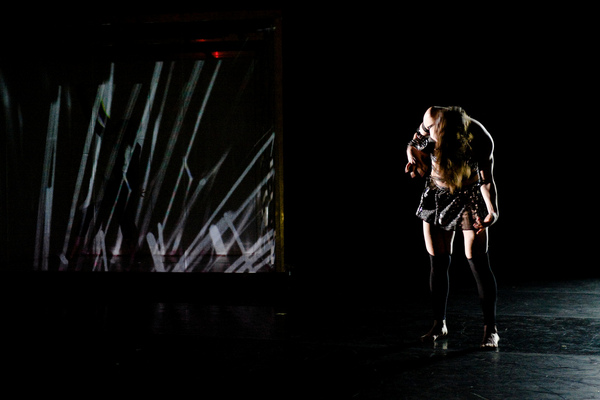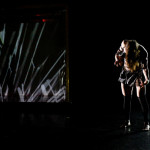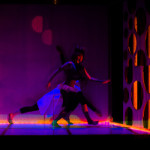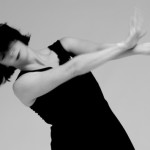By CHELSEY PHILPOT
On Friday April 11, 2008, as part of a CRASHarts presentation at the Institute of Contemporary Art, a piece by Kinodance, a Boston-based troupe with a mission to "make transparent the boundaries between dance, cinema, and visual arts," was the heart of the show. "Fuse," Kinodance's second world premiere piece of the evening, was as oddly captivating as a horror film. At times during the piece you might have wanted to turn away from the flashing lights or have plugged your ears against the cacophony erupting from the tinny piano located downstage left, but you could not. The energy of the piece, from the electric dancing to the haunting light design, was too engrossing and, like a film with blood and gore, you could not turn it off.
Kinodance began the evening with, "Behemoth." Alissa Cardone's knock-kneed movements and painful slams to the stage floor and set - which Kinodance designed to evoke the failed 18th century invention of the ocular harpsichord - gave the piece the substance that the audience remembered it by.
Unfortunately, "Here to There," performed in the second half of the presentation by Lorraine Chapman and Company, was pale in comparison to "Fuse." If the Lorraine Chapman Company had performed in isolation, Chapman's strength as a choreographer and innovator might have been more apparent. Dance Magazine did name her one of the "25 to Watch" in 2008, and while her individual performance was both bold and wonderfully quirky, her piece was weakened by group synchronization that was at times painfully off - a routine with canes had angles and limbs all over the place. There were also moments when some dancers gave in to the physical strains of the performance and dropped their comical facial expressions, breaking the spell of humor they had worked so hard to create.
The illusion the Kinodance created in "Fuse," however, flowed from tense beginning to tenser end. Cardone's, and fellow Kinodance arist, Ingrid Schatz's choreography in "Fuse" overshadowed Cardone's work in "Behemouth." Stagehands constructed the set as the audience waited patiently and with curiosity. The aforementioned upright piano, a large ladder constructed of equidistant industrial strip lights, and a television-shaped box, designed to mimic one of the first versions of the television, the "lumia box," and large enough to hold at least four dancers comfortably all contributed to the tableau. The Kinodancers began this piece with a dancer slinking into the box from the lighting cage above, setting a tone of mystery and sinewy athleticism.
For the longest time three of the four dancers in "Fuse" stretched and climbed around their lumia box like content cats in a cage, never touching each other. Finally, in one armrest-gripping sequence two of the dancers ganged up on a third dancer. The dancer, clad in a dominatrix-esque silver and black outfit out of a grade B space movie, clung to the walls, the ceiling, anywhere she could possibly make an escape as her aggressors moved closer and closer. The sexual tension they created moved in waves off the stage and continued even after the attacked dancer left the box. With the victim departed, the two dancers - one with blond hair that looked as if she had stuck a butter knife in an electric socket wore a metallic tutu and the other in a long asymmetrical white vest - twisted around each other like carnivores around a kill, until they touched, bringing "Fuse" to the beginning of the end.
Throughout the performance light and the white, gray and black images that illuminated the lumia box screen were as much a part of the performance as the four dancers. Light dictated their movements. It confined them to narrows swatches of stage at time and liberated them when the images on the lumia box screen flashed widely like television snow on a rogue channel. Alla Kovgan's Film and Video Design and Kathy Couch's Lighting design deserve as much attention as the liquid-like choreography.
Before the artistic collaboration of Kinodance, who knew dance, film, and the arts could be blended in such a way that the original boundaries between each medium ultimately seem to have never existed at all.
In their mission to fuse the various arts, Kinodance succeeds.
- Kinodance. “Fuse.” Photo: Kevin Bullis.
- Kinodance. “Fuse.” Photo: Kevin Bullis.
- Lorraine Chapman. Photo: John Gillooly
----
Kinodance
Lorraine Chapman
World Music/CRASHarts
ICA Performance
"Lorraine Chapman the Company & Kinodance" performed in the Barbara Lee Family Foundation Theater of ICA on April 12 and 11, 2008.
Kinodance images courtesy of Kinodance.
Chapman image courtesy of CRASHarts.







